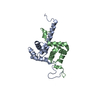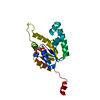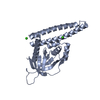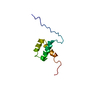[English] 日本語
 Yorodumi
Yorodumi- PDB-2mut: Solution structure of the F231L mutant ERCC1-XPF dimerization region -
+ Open data
Open data
- Basic information
Basic information
| Entry | Database: PDB / ID: 2mut | ||||||
|---|---|---|---|---|---|---|---|
| Title | Solution structure of the F231L mutant ERCC1-XPF dimerization region | ||||||
 Components Components |
| ||||||
 Keywords Keywords |  HYDROLASE / ERCC1-XPF / F231L / HYDROLASE / ERCC1-XPF / F231L /  Nucleotide Excision Repair Nucleotide Excision Repair | ||||||
| Function / homology |  Function and homology information Function and homology informationnegative regulation of double-stranded telomeric DNA binding / positive regulation of t-circle formation / pyrimidine dimer repair by nucleotide-excision repair / syncytium formation / telomeric DNA-containing double minutes formation / ERCC4-ERCC1 complex / negative regulation of protection from non-homologous end joining at telomere / negative regulation of telomere maintenance / nucleotide-excision repair involved in interstrand cross-link repair / nucleotide-excision repair factor 1 complex ...negative regulation of double-stranded telomeric DNA binding / positive regulation of t-circle formation / pyrimidine dimer repair by nucleotide-excision repair / syncytium formation / telomeric DNA-containing double minutes formation / ERCC4-ERCC1 complex / negative regulation of protection from non-homologous end joining at telomere / negative regulation of telomere maintenance / nucleotide-excision repair involved in interstrand cross-link repair / nucleotide-excision repair factor 1 complex / nucleotide-excision repair complex / response to sucrose / t-circle formation / single-stranded DNA endodeoxyribonuclease activity / resolution of meiotic recombination intermediates /  mitotic recombination / mitotic recombination /  UV protection / post-embryonic hemopoiesis / UV protection / post-embryonic hemopoiesis /  isotype switching / UV-damage excision repair / negative regulation of telomere maintenance via telomere lengthening / HDR through Single Strand Annealing (SSA) / isotype switching / UV-damage excision repair / negative regulation of telomere maintenance via telomere lengthening / HDR through Single Strand Annealing (SSA) /  oogenesis / TFIID-class transcription factor complex binding / response to immobilization stress / response to X-ray / oogenesis / TFIID-class transcription factor complex binding / response to immobilization stress / response to X-ray /  replicative senescence / positive regulation of transcription initiation by RNA polymerase II / embryonic organ development / response to cadmium ion / interstrand cross-link repair / response to UV / replicative senescence / positive regulation of transcription initiation by RNA polymerase II / embryonic organ development / response to cadmium ion / interstrand cross-link repair / response to UV /  telomere maintenance / response to nutrient / DNA endonuclease activity / insulin-like growth factor receptor signaling pathway / telomere maintenance / response to nutrient / DNA endonuclease activity / insulin-like growth factor receptor signaling pathway /  regulation of autophagy / promoter-specific chromatin binding / determination of adult lifespan / nucleotide-excision repair / Fanconi Anemia Pathway / double-strand break repair via homologous recombination / multicellular organism growth / Dual Incision in GG-NER / Formation of Incision Complex in GG-NER / double-strand break repair via nonhomologous end joining / Dual incision in TC-NER / male gonad development / cellular response to UV / regulation of autophagy / promoter-specific chromatin binding / determination of adult lifespan / nucleotide-excision repair / Fanconi Anemia Pathway / double-strand break repair via homologous recombination / multicellular organism growth / Dual Incision in GG-NER / Formation of Incision Complex in GG-NER / double-strand break repair via nonhomologous end joining / Dual incision in TC-NER / male gonad development / cellular response to UV /  single-stranded DNA binding / single-stranded DNA binding /  spermatogenesis / response to oxidative stress / cell population proliferation / damaged DNA binding / spermatogenesis / response to oxidative stress / cell population proliferation / damaged DNA binding /  chromosome, telomeric region / chromosome, telomeric region /  Hydrolases; Acting on ester bonds / Hydrolases; Acting on ester bonds /  DNA repair / DNA repair /  nucleoplasm / identical protein binding / nucleoplasm / identical protein binding /  nucleus / nucleus /  cytoplasm cytoplasmSimilarity search - Function | ||||||
| Biological species |   Homo sapiens (human) Homo sapiens (human) | ||||||
| Method |  SOLUTION NMR / restrained molecular dynamics SOLUTION NMR / restrained molecular dynamics | ||||||
| Model details | lowest energy, model1 | ||||||
 Authors Authors | Faridounnia, M. / Wienk, H. / Kovacic, L. / Folkers, G.E. / Jaspers, N.G.J. / Kaptein, R. / Hoeijmakers, J.H.J. / Boelens, R. | ||||||
 Citation Citation |  Journal: J.Biol.Chem. / Year: 2015 Journal: J.Biol.Chem. / Year: 2015Title: The Cerebro-oculo-facio-skeletal Syndrome Point Mutation F231L in the ERCC1 DNA Repair Protein Causes Dissociation of the ERCC1-XPF Complex. Authors: Faridounnia, M. / Wienk, H. / Kovacic, L. / Folkers, G.E. / Jaspers, N.G. / Kaptein, R. / Hoeijmakers, J.H. / Boelens, R. | ||||||
| History |
|
- Structure visualization
Structure visualization
| Structure viewer | Molecule:  Molmil Molmil Jmol/JSmol Jmol/JSmol |
|---|
- Downloads & links
Downloads & links
- Download
Download
| PDBx/mmCIF format |  2mut.cif.gz 2mut.cif.gz | 1.1 MB | Display |  PDBx/mmCIF format PDBx/mmCIF format |
|---|---|---|---|---|
| PDB format |  pdb2mut.ent.gz pdb2mut.ent.gz | 918 KB | Display |  PDB format PDB format |
| PDBx/mmJSON format |  2mut.json.gz 2mut.json.gz | Tree view |  PDBx/mmJSON format PDBx/mmJSON format | |
| Others |  Other downloads Other downloads |
-Validation report
| Arichive directory |  https://data.pdbj.org/pub/pdb/validation_reports/mu/2mut https://data.pdbj.org/pub/pdb/validation_reports/mu/2mut ftp://data.pdbj.org/pub/pdb/validation_reports/mu/2mut ftp://data.pdbj.org/pub/pdb/validation_reports/mu/2mut | HTTPS FTP |
|---|
-Related structure data
| Similar structure data | |
|---|---|
| Other databases |
- Links
Links
- Assembly
Assembly
| Deposited unit | 
| |||||||||
|---|---|---|---|---|---|---|---|---|---|---|
| 1 |
| |||||||||
| NMR ensembles |
|
- Components
Components
| #1: Protein | Mass: 10985.669 Da / Num. of mol.: 1 / Fragment: UNP residues 220-297 / Mutation: F231L Source method: isolated from a genetically manipulated source Source: (gene. exp.)   Homo sapiens (human) / Gene: ERCC1 / Production host: Homo sapiens (human) / Gene: ERCC1 / Production host:   Escherichia coli (E. coli) / Strain (production host): BL21 / References: UniProt: P07992 Escherichia coli (E. coli) / Strain (production host): BL21 / References: UniProt: P07992 |
|---|---|
| #2: Protein | Mass: 9230.518 Da / Num. of mol.: 1 / Fragment: UNP residues 834-916 Source method: isolated from a genetically manipulated source Source: (gene. exp.)   Homo sapiens (human) / Gene: ERCC4, ERCC11, XPF / Production host: Homo sapiens (human) / Gene: ERCC4, ERCC11, XPF / Production host:   Escherichia coli (E. coli) / Strain (production host): BL21 Escherichia coli (E. coli) / Strain (production host): BL21References: UniProt: Q92889,  Hydrolases; Acting on ester bonds Hydrolases; Acting on ester bonds |
-Experimental details
-Experiment
| Experiment | Method:  SOLUTION NMR SOLUTION NMR | ||||||||||||||||||||||||
|---|---|---|---|---|---|---|---|---|---|---|---|---|---|---|---|---|---|---|---|---|---|---|---|---|---|
| NMR experiment |
|
- Sample preparation
Sample preparation
| Details | Contents: 0.4 mM [U-100% 13C; U-100% 15N] protein_1, 0.4 mM [U-100% 13C; U-100% 15N] protein_2, 8 % D2O, 50 mM sodium phosphate, 100 mM sodium chloride, 92% H2O/8% D2O Solvent system: 92% H2O/8% D2O | ||||||||||||||||||||||||
|---|---|---|---|---|---|---|---|---|---|---|---|---|---|---|---|---|---|---|---|---|---|---|---|---|---|
| Sample |
| ||||||||||||||||||||||||
| Sample conditions | Ionic strength: 250 / pH: 7.0 / Pressure: ambient / Temperature: 290 K |
-NMR measurement
| NMR spectrometer |
|
|---|
- Processing
Processing
| NMR software |
| ||||||||||||||||||||||||
|---|---|---|---|---|---|---|---|---|---|---|---|---|---|---|---|---|---|---|---|---|---|---|---|---|---|
| Refinement | Method: restrained molecular dynamics / Software ordinal: 1 | ||||||||||||||||||||||||
| NMR representative | Selection criteria: lowest energy | ||||||||||||||||||||||||
| NMR ensemble | Conformer selection criteria: structures with the lowest energy Conformers calculated total number: 100 / Conformers submitted total number: 20 |
 Movie
Movie Controller
Controller










 PDBj
PDBj







